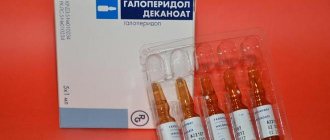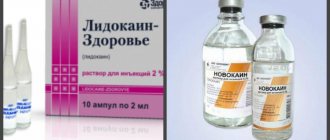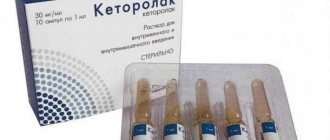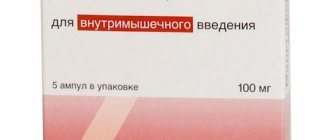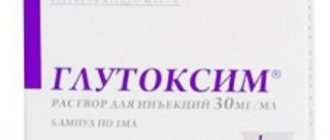Indications
Dexalgin 25 is used to relieve pain of various origins (for example, with renal colic, toothache, neuralgia, radiculitis, as well as sciatica, with algodismenorrhea, in the event of post-traumatic and postoperative pain, pain with bone metastases).
Dexalgin 25 is indicated for the symptomatic treatment of both acute and chronic inflammatory, inflammatory-degenerative, and metabolic diseases of the musculoskeletal system (in the case of spondyloarthritis, rheumatoid arthritis, osteochondrosis and osteoarthritis).
In these cases, Dexalgin 25 is prescribed for pain relief and as an anti-inflammatory agent.
Contraindications
Contraindication is hypersensitivity to dexketoprofen or to the components of the drug, as well as to other NSAIDs.
The presence of peptic ulcer of the stomach and duodenum in the acute phase, if there is a history of gastrointestinal bleeding, as well as in cases of other active bleeding (for example, if intracranial bleeding is suspected), with anticoagulant therapy, hemorrhagic diathesis and other coagulation disorders.
Not used in cases of exacerbation of inflammatory bowel diseases (Crohn's disease, ulcerative colitis).
In severe liver dysfunction (10-15 points on the Child-Pugh scale), as well as in severe or moderate renal dysfunction (with creatinine clearance less than 50 ml/min).
Dexalgin 25 is contraindicated in complete or incomplete combination of bronchial asthma, recurrent polyposis and intolerance to acetylsalicylic acid or other NSAIDs (also in history).
In case of severe heart failure, after coronary artery bypass grafting.
Dexalgin 25 is not used for the treatment of children under 18 years of age, as well as during pregnancy and breastfeeding.
Use with caution if you have a history of allergic reactions; for blood clotting disorders; in the presence of systemic lupus erythematosus, as well as mixed connective tissue diseases; with simultaneous use of other drugs; in a state of severe hypovolemia; with existing coronary heart disease; for cerebrovascular diseases.
Caution is required in the presence of diabetes mellitus or hyperlipidemia, in the case of peripheral arterial diseases, and also if there is a history of information about the development of ulcerative lesions of the gastrointestinal tract; with long-term use of NSAIDs. Use with caution when smoking, alcoholism, and in old age (after 65 years).
Dexalgin® 25 (Dexalgin® 25)
The following interactions are common to all NSAIDs.
Undesirable combinations
With other NSAIDs, including salicylates in high doses (more than 3 g/day):
simultaneous use of several NSAIDs due to the synergistic effect increases the risk of gastrointestinal bleeding and ulcers.
With anticoagulants
: Dexketoprofen, like other NSAIDs, may enhance the effect of anticoagulants such as warfarin due to high plasma protein binding, inhibition of platelet aggregation and damage to the gastrointestinal mucosa. If simultaneous use is necessary, careful monitoring of the patient's condition and regular monitoring of laboratory parameters is necessary.
With heparin:
with simultaneous use, the risk of bleeding increases (due to inhibition of platelet aggregation and damaging effects on the mucous membrane of the gastrointestinal tract). If simultaneous use is necessary, careful monitoring of the patient's condition and regular monitoring of laboratory parameters is necessary.
With glucocorticosteroids:
with simultaneous use, the risk of ulcerative lesions of the gastrointestinal tract and bleeding increases.
With lithium preparations:
NSAIDs increase the concentration of lithium in the blood plasma up to toxic levels, and therefore this indicator must be monitored when used simultaneously with dexketoprofen, changing the dosage, and also after discontinuation of NSAIDs.
With methotrexate in high doses (15 mg/week or more):
it is possible to increase the hematological toxicity of methotrexate due to a decrease in its renal clearance when used simultaneously with NSAIDs.
With hydantoins and sulfonamides:
their toxic effect may be enhanced.
Combinations
requiring caution
With diuretics, angiotensin-converting enzyme (ACE) inhibitors, aminoglycoside antibiotics, angiotensin II :
simultaneous use with NSAIDs is associated with a risk of developing acute renal failure in dehydrated patients (decreased glomerular filtration rate due to decreased synthesis of prostaglandins). When used concomitantly, NSAIDs may reduce the antihypertensive effect of some drugs. When using dexketoprofen and diuretics simultaneously, it is necessary to ensure that the patient has no signs of dehydration, and also monitor renal function at the beginning of simultaneous use.
With methotrexate in low doses (less than 15 mg/week):
it is possible to increase the hematological toxicity of methotrexate due to a decrease in its renal clearance during simultaneous use with NSAIDs. A blood cell count is necessary when coadministration is initiated. In the presence of even mild renal dysfunction, as well as in elderly people, careful medical supervision is necessary.
With pentoxifylline:
there may be an increased risk of bleeding. Close clinical monitoring and regular checking of bleeding time (blood clotting time) is necessary.
With zidovudine:
There is a risk of increased toxicity to red blood cells due to effects on reticulocytes, with the development of severe anemia one week after starting NSAID use. It is necessary to conduct a general blood test with counting the number of reticulocytes 1-2 weeks after starting NSAID therapy.
With oral hypoglycemic agents:
NSAIDs may enhance the hypoglycemic effect of sulfonylureas due to the displacement of sulfonylurea from sites of binding to plasma proteins.
Combinations
that
need to be taken into account
With
beta -blockers:
When used simultaneously with NSAIDs, the antihypertensive effect of beta-blockers may be reduced due to inhibition of prostaglandin synthesis.
With cyclosporine and tacrolimus:
NSAIDs may increase nephrotoxicity, which is mediated by the action of renal prostaglandins. During simultaneous use, it is necessary to monitor renal function.
With thrombolytics:
the risk of bleeding increases.
The risk of bleeding from the gastrointestinal tract increases when used simultaneously with serotonin reuptake inhibitors
(citalopram, fluoxetine, sertraline) and anticoagulants.
With probenecid:
it is possible to increase the concentration of NSAIDs in the blood plasma, which may be due to the inhibitory effect of probenecid on renal tubular secretion and/or conjugation with glucuronic acid; NSAID dose adjustment may be required.
With cardiac glycosides:
simultaneous use with NSAIDs may lead to an increase in the concentration of cardiac glycosides in the blood plasma.
With mifepristone:
Due to the theoretical risk of changes in the effectiveness of mifepristone under the influence of prostaglandin synthesis inhibitors, NSAIDs should not be used earlier than 8-12 days after discontinuation of mifepristone.
With quinolones:
Data obtained from experimental studies in animals indicate a high risk of developing seizures when NSAIDs are used concomitantly with quinolones in high doses.
If necessary, simultaneous use of the drug Dexalgin
®
25 with the above medications, you should consult your doctor.
Mode of application
Dexalgin 25 is taken orally with meals.
The dosage depends on the intensity of the pain syndrome, with the recommended dose for adults being 12.5 mg (1/2 tablet) every 4-6 hours or 25 mg (1 tablet) every 8 hours. The maximum daily dose is 75 mg.
In patients of the older age group, as well as in patients with impaired liver and/or kidney function, use
Dexalgin 25 is started with lower doses, and the maximum daily dose is 50 mg.
It should be remembered that Dexalgin 25 is not intended for long-term therapy; the course of treatment should not exceed 3-5 days.
Directions for use and doses
Installed individually.
The average recommended single dose is 12.5 mg (1/2 tablet) 1 to 6 times/day every 4-6 hours as needed or 25 mg (1 tablet) 1 to 3 times/day every 8 hours.
The maximum daily dose is 75 mg (6 tablets).
In patients with impaired liver or kidney function, or in the elderly, the drug should be started in lower doses - no more than 50 mg / day.
The drug is not intended for long-term use: the duration of use should not exceed 3-5 days.
Side effects
When using Dexalgin 25, various side effects may occur:
- Blurred vision and occasional tinnitus may occur.
- Very rarely, neutropenia and thrombocytopenia are possible.
- Infrequently, headache, dizziness, insomnia, or drowsiness may occur; Paresthesia is rarely possible.
- From the cardiovascular system: infrequently, a feeling of heat and redness of the skin may occur; Extrasystole rarely appears, blood pressure may increase, and cases of tachycardia or decreased blood pressure are very rare.
- From the respiratory system: bradypnea may rarely occur; cases of bronchospasm or shortness of breath are very rare.
- From the gastrointestinal tract: a feeling of nausea or vomiting, dyspepsia and diarrhea, abdominal pain may occur, constipation, flatulence, and dry mouth may occur infrequently. Rarely, erosions and ulcers may occur in the gastrointestinal tract, as well as bleeding from an ulcer or its perforation. Damage to the pancreas is very rare.
- From the liver and biliary tract: rarely, increased activity of liver enzymes may occur and jaundice may appear; very rarely the liver may be affected.
- From the genitourinary system: polyuria may rarely occur; cases of nephritis or nephrotic syndrome are very rare, disturbances in the menstrual cycle in women are rare, and in men, with long-term use, temporary dysfunction of the prostate gland may occur.
- From the musculoskeletal system: rarely, muscle spasms, back pain, and difficulty in the motor function of joints may occur.
- From the skin: infrequently - cases of dermatitis, rash; rarely the appearance of urticaria or acne, as well as sweating; very rarely, cases of severe skin reactions (such as Stevens-Johnson syndrome, Lyell's syndrome), as well as the occurrence of angioedema, allergic dermatitis and photosensitivity are possible.
- Cases of hypo- or hyperglycemia, as well as hypertriglyceridemia, are rare.
- Laboratory findings may (rarely) include ketonuria or proteinuria.
- General disturbances may include (infrequently) fever, fatigue; very rarely there is a possibility of anaphylactic shock and facial swelling.
- Rarely, aseptic meningitis can occur, mainly in patients with systemic lupus erythematosus, as well as mixed connective tissue diseases. Hematological disorders may also appear (purpura, anemia - both aplastic and hemolytic); the likelihood of agranulocytosis and bone marrow hypoplasia is very rare.
Overdose
Symptoms of overdose may include nausea, abdominal pain, headache or dizziness. Insomnia, disorientation, and anorexia may occur.
Treatment of overdose depends on the symptoms that appear. If necessary, gastric lavage and hemodialysis are allowed.
special instructions
Interactions are typical for all NSAIDs.
Undesirable combinations:
- With other NSAIDs, including salicylates in high doses (more than 3 g per day), since when taking several NSAIDs simultaneously, a synergistic effect occurs, which increases the likelihood of gastrointestinal bleeding and ulcerative phenomena.
- With oral anticoagulants, heparin, in doses higher than prophylactic, as well as with ticlopidine: the risk of bleeding increases due to inhibition of platelet aggregation and damage to the gastrointestinal mucosa.
- With lithium preparations: NSAIDs can increase the concentration of lithium in the blood, up to toxic levels; therefore, monitoring this indicator is necessary both when using or changing the dose, and after discontinuation of NSAIDs.
- With methotrexate in high doses (15 mg per week or more): during NSAID therapy, its renal clearance decreases and, as a consequence, the hematological toxicity of methotrexate increases.
- With hydantoins and sulfonamides: the risk of toxic effects of these drugs increases.
Combinations requiring caution
- With diuretics, ACE inhibitors: in this case, the use of NSAIDs can cause the development of acute renal failure in patients with reduced water balance, since with a decrease in PG synthesis, glomerular filtration may decrease. NSAIDs can also reduce the therapeutic effect of some antihypertensive drugs.
- With low-dose methotrexate (less than 15 mg per week): the use of NSAIDs reduces the renal clearance of methotrexate, which in turn increases its hematological toxicity. In this regard, during the period of joint therapy, weekly blood cell counts are recommended, especially in the first week. In case of existing renal dysfunction, even to a mild degree, as well as in patients of the older age group, careful monitoring is necessary.
- The likelihood of developing bleeding from the gastrointestinal tract increases with the simultaneous use of NSAIDs and serotonin reuptake inhibitors (for example, fluoxetine, citalopram, sertraline), and oral glucocorticoids.
- With pentoxifylline: when used together, the likelihood of bleeding also increases.
- Constant monitoring of blood clotting time is necessary.
- With zidovudine: There is a potential for increased risk of toxic effects on red blood cells, which in turn are due to effects on reticulocytes, which may lead to anemia one week after starting NSAID use. In this case, after one or two weeks of therapy, a blood test and reticulocyte count are required.
- With sulfonylurea derivatives: NSAIDs have the ability to enhance the hypoglycemic effect of sulfonylureas, displacing it from sites of binding to plasma proteins.
- With low molecular weight heparin preparations: due to an increased likelihood of bleeding.
Combinations to consider
- With β-blockers: NSAIDs, by inhibiting the synthesis of PG, are thereby able to reduce the hypotensive effect of β-blockers.
- With cyclosporine and tacrolimus: NSAIDs may increase nephrotoxicity, which is mediated by the action of renal PGs. During concomitant therapy, monitoring of renal function is required.
- With thrombolytics: the likelihood of bleeding increases.
- With probenecid: plasma concentrations of NSAIDs may increase, this may be due to the inhibitory effect of probenecid on renal tubular secretion and/or conjugation with glucuronic acid, in which case it is necessary to adjust the NSAID dosage if necessary.
- With cardiac glycosides: there is a possibility that NSAIDs may increase plasma concentrations of glycosides.
- With mifepristone: the use of NSAIDs is not recommended earlier than 8-12 days after stopping mifepristone, since theoretically there is a possibility of a change in the effectiveness of mifepristone due to the influence of PG synthesis inhibitors.
- With quinolones: Based on experimental animal studies, there is a risk of seizures when using NSAIDs in conjunction with high-dose quinolone therapy.
Like other NSAIDs, Dexalgin 25 can increase the concentration of creatinine and nitrogen in plasma; Dexalgin 25 can also have a side effect on the urinary system, and there is a possibility of interstitial nephritis or glomerulonephritis, as well as papillary necrosis, nephrotic syndrome and acute renal failure.
During therapy with Dexalgin 25, a slight transient increase in liver parameters and a significant increase in the activity of AST and ALT in the serum sometimes occur. In this regard, in patients of the older age group it is necessary to monitor the functions of the liver and kidneys. In case of a significant increase in indicators, it is recommended to discontinue the use of Dexalgin 25.
Dexketoprofen therapy can hide the symptoms of infectious diseases. If you suspect an infection or if your condition worsens while using Dexalgin 25, you should immediately consult a doctor.
When using Dexalgin 25, there is a possibility of a feeling of drowsiness, and dizziness may also occur, while the patient’s ability to concentrate and the speed of psychomotor reactions may decrease in the first hours after taking the drug.
In this regard, during therapy with Dexalgin 25, caution is required when driving vehicles or during activities that require concentration and speed of psychomotor reactions.
Dexalgin
The following drug interactions are typical for all NSAIDs, including Dexalgin®.
Undesirable combinations
The simultaneous administration of several NSAIDs, including salicylates in high doses (more than 3 g / day), increases the risk of gastrointestinal bleeding and ulcers due to the synergy of action.
When used simultaneously with oral anticoagulants, heparin in doses exceeding prophylactic doses, and ticlopidine, the risk of bleeding increases due to inhibition of platelet aggregation and damage to the gastrointestinal mucosa.
NSAIDs increase the concentration of lithium in the blood plasma, up to toxic levels, and therefore this indicator must be monitored when prescribing, changing the dose and after discontinuation of NSAIDs.
When used with methotrexate in high doses (15 mg/week or more), the hematological toxicity of methotrexate increases due to a decrease in its renal clearance during NSAID therapy.
When used simultaneously with hydantoins and sulfonamide drugs, there is a risk of increased toxic effects of these drugs.
Combinations requiring caution
If simultaneous use with diuretics and ACE inhibitors is necessary, it should be taken into account that NSAID therapy is associated with the risk of developing acute renal failure in patients with dehydration (decreased glomerular filtration due to inhibition of prostaglandin synthesis). NSAIDs may reduce the hypotensive effect of some drugs. When coadministered with diuretics, ensure that the patient's fluid balance is adequate and monitor renal function before prescribing NSAIDs.
When used simultaneously with methotrexate in low doses (less than 15 mg/week), the hematological toxicity of methotrexate may increase due to a decrease in its renal clearance during NSAID therapy. Blood cell counts should be monitored weekly during the first weeks of concomitant therapy. In the presence of even mild renal dysfunction, as well as in elderly people, careful medical supervision is necessary.
When used simultaneously with pentoxifylline, the risk of bleeding increases. Intensive clinical monitoring and frequent monitoring of bleeding time (blood clotting time) is necessary.
When used concomitantly with zidovudine, there is a risk of increased toxicity to red blood cells due to effects on reticulocytes, with the development of severe anemia one week after administration of NSAIDs. It is necessary to control all blood cells and reticulocytes after 1-2 weeks. after starting NSAID therapy.
It is possible that the hypoglycemic effect of sulfonylurea derivatives may be enhanced due to its displacement from sites of binding to plasma proteins under the influence of NSAIDs.
When used simultaneously with low molecular weight heparin drugs, the risk of bleeding increases.
Combinations to consider
NSAIDs may reduce the hypotensive effect of beta-blockers due to inhibition of prostaglandin synthesis.
When used concomitantly with cyclosporine and tacrolimus, NSAIDs may increase nephrotoxicity, which is mediated by the action of renal prostaglandins. During combination therapy, it is necessary to monitor renal function.
When prescribed simultaneously with thrombolytics, the risk of bleeding increases.
When used concomitantly with probenecid, plasma concentrations of NSAIDs may increase, which may be due to inhibition of renal secretion and/or conjugation with glucuronic acid. This requires NSAID dose adjustment.
NSAIDs can cause an increase in the concentration of cardiac glycosides in the blood plasma.
Due to the theoretical risk of changes in the effectiveness of mifepristone under the influence of prostaglandin synthesis inhibitors, NSAIDs should not be prescribed earlier than 8-12 days after discontinuation of mifepristone.
Data obtained from experimental studies in animals indicate a high risk of developing convulsions when NSAIDs are prescribed during therapy with high doses of ciprofloxacin.
Pharmaceutical interactions
Dexalgin® should not be mixed in the same syringe with a solution of dopamine, promethazine, pentazocine, pethidine or hydroxyzine (a precipitate will form).
Dexalgin® can be mixed in one syringe with a solution of heparin, lidocaine, morphine and theophylline.
A diluted solution of Dexalgin® for infusion should not be mixed with promethazine or pentazocine.
A diluted solution of Dexalgin® for infusion is compatible with the following injection solutions: dopamine, heparin, hydroxyzine, lidocaine, morphine, pethidine and theophylline.
When diluted solutions of Dexalgin® for infusion are stored in plastic containers or when using infusion systems made from ethyl vinyl acetate, cellulose propionate, low-density polyethylene or polyvinyl chloride, absorption of the active substance by the listed materials does not occur.


